USDOT Thriving Communities Program: Suffolk, NY
15 minutes Date Launched/Enacted: May 15, 2025 Date Published: May 22, 2025

About the Thriving Communities Program (TCP)
The Thriving Communities Program (TCP) funds tailored technical assistance to under-resourced and disadvantaged communities, helping them better access historic infrastructure investments and deliver transformative projects. The USDOT FY 2022 Thriving Communities Program supports 64 communities across the country with access to a team of capacity builders to develop innovative community engagement methods, identify funding opportunities, and grow long-term capacity to develop and deliver transportation projects that strengthen communities.
TCP Complete Neighborhoods Community of Practice
TCP Communities are grouped into three Communities of Practice: Main Streets, Networked Communities, and Complete Neighborhoods. The 15 communities included under the Complete Neighborhoods Community of Practice are:
| Atlantic Beach, SC | Isabela, PR | Santa Cruz, CA |
| Billings, MT | Lansing, MI | St. Louis County, MO |
| Decatur, IL | Lima, OH | Suffolk, NY |
| East Orange, NJ | Providence, RI | Sumter, SC |
| Indianapolis, IN | Roanoke, VA | Waukegan, IL |
The US Department of Transportation (USDOT) selected a capacity building team led by RMI, including: the American Council for Energy-Efficient Economy (ACEEE), Equitable Cities, Nelson\Nygaard, and the Shared-Use Mobility Center (SUMC), to provide technical assistance to these 15 communities.

A Snapshot of Suffolk County, NY
Suffolk County is situated on the eastern section of Long Island, about 15 miles east of New York City. It is the second largest county by land area in New York after St. Lawrence County upstate. The county’s median household income is $124,045, about 1.5 times the state’s median household income of $82,095, and 6.8% people in the county live below poverty line, about half the rate of the rest of the state. The population is 1,523,170 (2023, ACS 1-year). Most residents drive to work and have an average commute time of 32.3 minutes for all commuters. All households spend about 18% of their income on transportation (H+T Index), in comparison with households across the county, which spend 17% of their income on transportation, based on 2023 data (US Bureau of Labor Statistics).
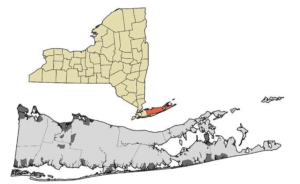
Suffolk County (in gray) in context within New York State (in yellow).
Key Partners
Suffolk County worked with the Trust for Public Land in the effort to apply for RAISE grant funding during the Thriving Communities Program. The Trust for Public Land is a non-profit that has been operating since 1972, working throughout the United States to create, protect, and steward quality parks and green spaces.
Vision Long Island was a key partner for Suffolk County Department of Economic Development and Planning during the Thriving Communities program. Vision is a non-profit organization that supports the growth of mixed-used/mixed-income communities that are pedestrian-friendly, accessible by public transit, and affordable. The organization has been working on Long Island for the last 25 years.

Stakeholder map. Credit: SUMC
The role of the Capacity Builders was to leverage existing resources and community partners within Suffolk County to grow local interest in the transportation programs and Vision Zero. This led to Suffolk County’s involvement in Vision Long Island’s Complete Streets Summit and collaboration between the two organizations on planning streetscape projects to improve safety in the county. The team also worked with the Trust for Public Land to complete a RAISE grant in 2024.
Activities through the Thriving Communities Program
RAISE Grant Application
In early 2024, Suffolk County and the Trust for Public Land (TPL) sought a $16.4 million FY24 RAISE grant from the U.S. Department of Transportation (USDOT) to help with the construction of the Long Island Greenway, which would fill a major gap in the county’s existing bike/trail network and address critical safety needs. The Capacity Building team lead Nelson\Nygaard provided support for the grant application, including completing the cost/benefit analysis. While the application was not funded in that round, it received a high score and was ultimately awarded in the FY25 RAISE grant cycle, with the win announced in January 2025. USDOT awarded $16.4 million in federal funding to Suffolk County for the first phase of construction of the greenway, the 12-mile Brentwood to Bethpage connector. Per TPL, the segment “marks the beginning of the Long Island Greenway, a transformative 175-mile trail network connecting communities from Manhattan to Montauk” and provides safe routes for people walking and biking to work, school, recreation, and other destinations.
The project will directly improve outcomes for disadvantaged communities by enhancing access to green space, providing access to high-quality transportation infrastructure, and improving connections to resources such as schools, employment, medical facilities, and public transit. The TPL first identified the route to create the Long Island Greenway in 2018 (NYS Parks, Recreation, and Historic Preservation). Suffolk County previously received RAISE grant funding in 2023 to plan 50 miles of the greenway from Riverhead to Montauk, and the latest funding will allow the county to construct the Brentwood to Bethpage segment.
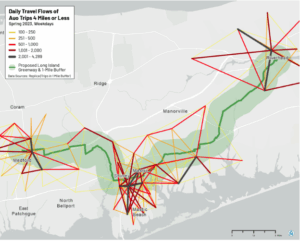
Map of travel flows showing short auto trips. Credit: Nelson\Nygaard
The Capacity Building team used Replica data to analyze existing travel patterns along Suffolk County’s proposed greenway alignment. This work supported Suffolk County ongoing greenway work related to the RAISE grant. The team conducted analysis within one mile of the proposed greenway alignment, finding that there is potential demand to shift trips to other modes by examining auto trips of less than 4 miles and providing additional transportation options. The analysis estimated nearly 150,000 daily short auto trips in the vicinity of the alignment, with strong flows between the streets of Shirley and Mastic, along William Floyd Parkway, between Shirley/Mastic and Manorville/Eastport, and between Riverhead and areas immediately south.
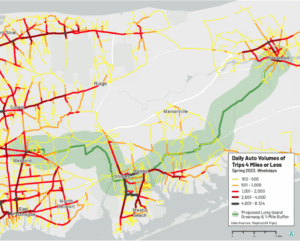
Map showing daily volumes of short auto trips. Credit: Nelson\Nygaard
Suffolk County was able to use this analysis, showing travel flows as well as volume data, for proof of concept for greenway usage as well as to help calculations for the cost-benefit analysis in the RAISE grant application.

Map showing daily biking volumes in the municipalities around the proposed greenway alignment. Credit: Nelson\Nygaard
Community Engagement
Site Visit
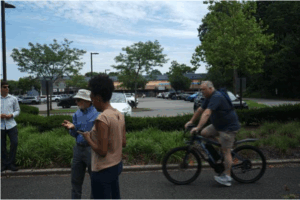
July 2024 site visit with Suffolk County. Credit: Nelson\Nygaard
The Department of Economic Development and Planning for Suffolk County held a site visit in July 2024 with the Capacity Building team. The primary purpose of the site visit was for capacity builders to re-engage with Suffolk by meeting in person to better understand the county’s challenges, re-establish relationships with the team, and engage stakeholders.
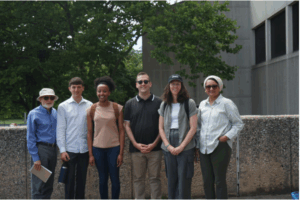
Suffolk County staff and the Capacity Builder team at the site visit in July 2024. Credit: Nelson\Nygaard
As a result of the site visit, Suffolk County and the Capacity Building team identified project priorities for Suffolk and next steps for collaboration between capacity builders, county departments, and local municipalities and non-profit organizations. Due to Suffolk County’s status as the county with the highest rates of crashes and traffic deaths in New York State, the team identified a Vision Zero* Summit as a priority for the county, recognizing it as a crucial step for addressing these challenges through a collaborative, multi-disciplinary approach.
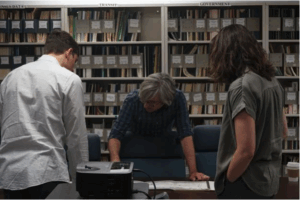
Going through archives and engaging with planning staff in Suffolk. Credit: Nelson\Nygaard
The county named many barriers to addressing Vision Zero, including project workload and timelines, and a need for stronger municipal relationships.
*Vision Zero refers to a road traffic safety initiative aimed at eliminating all traffic fatalities and severe injuries.
Summit
Following the site visit, the capacity builder team worked with Suffolk County to organize a Vision Zero Summit, a call to action for internal and external stakeholder groups to advance safety projects and policy changes throughout the county to address the rise in traffic fatalities. Long Island newspaper Newsday has created an investigative series covering dangerous roads throughout the region in addition to an interactive database to search for fatal crashes on Long Island, both of which helped provide context and helped to create a framing for Summit planning.
The Capacity Building team collaborated with the Suffolk County team to join Vision Long Island’s 18th annual Complete Streets Summit on April 8, 2025. Vision Long Island led the first half of the event, leading a walk audit, a panel, and talks from leading experts on street safety from around the region. The Capacity Building team led the second half of the event, facilitating conversations and design exercises related to Vision Zero.
One key takeaway from the event for Vision Long Island and the Suffolk County team was an increase in Vision Zero awareness. Representatives from Vision Long Island said that more people have been asking them about Vision Zero, and the organization coordinating more walk audits because of the summit, coordinating in September and November for car-free weeks. The event has also motivated the Suffolk County team to talk about taking immediate action working on small-scale projects like bulb outs and painted crosswalks. The team has begun discussing partnership with local schools demonstration grants. The team highlighted this as an easy win because it would allow the county to work on street safety projects despite challenges with the town and village administrations.
Although many participants at the summit focused more on driver education and changes to vehicle manufacturing than infrastructure and design, the team was optimistic about the success of slowly changing the narrative to “design matters.” One team member noted that in the past, parts of the region were skeptical about Transit-Oriented Development, but once one community started using it, other communities have a catalyzing moment and people start accepting it more.
Walk Audit
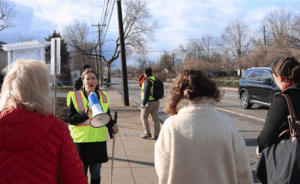
Elissa Kyle of Vision Long Island led the walk audit. Credit: Nelson\Nygaard
Vision Long Island led a walk audit at the beginning of the Summit on Deer Park Road in Suffolk County. Elissa Kyle of Vision Long Island led the audit and invited participants to take note of features that made it difficult to walk on this stretch of road. Participants discussed their experience of what it was like along the road and voiced different safety concerns. Those in attendance noticed that sidewalks along much of the route were inadequate (crumbling, narrow, or not present) and some crossings were inadequate (missing crosswalks and curb cuts pointed toward the road).

Missing sidewalks along the walk audit. Credit: Nelson\Nygaard
Root Cause Exercise
As part of the Summit, Dru van Hengel from Nelson\Nygaard led a root cause analysis exercise to help the audience identify core causes of crashes on Suffolk County roads. The interactive workshop helped participants identify practical next-step solutions for improving safety in the region.
Participants identified various symptoms of the lack of good infrastructure and road design: the fact that Suffolk County roads focus on highways that connect towns rather than infrastructure for pedestrians and cyclists, residents opting for cars over other modes, social isolation, the fact that people are leaving Long Island, and economic loss.
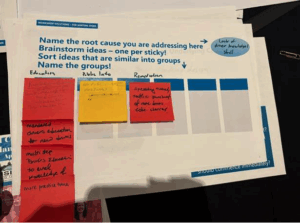
Root cause exercise. Credit: Nelson\Nygaard
Many solutions that participants focused on included policy changes, such as increasing driver education, especially at the high school level, as well as pushing for incentives through insurance to require driver’s ed for high school students. Others also focused on changes to vehicle manufacturing, such as forcing vehicle manufacturers to limit vehicle speeds and making cars annoy drivers when they break the rules. Some suggested design changes such as staggered lights and speed cameras and camera enforcement.
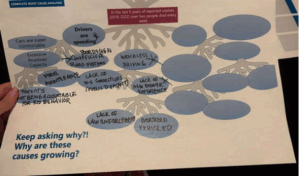
Root cause exercise. Credit: Nelson\Nygaard
Design Exercise
After the Root Cause Analysis, capacity builders led a design exercise as part of the Summit. Capacity builders helped frame this exercise with context on traffic safety in Suffolk County: on average, over two people died in all crashes on roadways in the county every week from 2018-2022, according to CLEAR data. Speeding and driver inattention are major problems in Suffolk County.
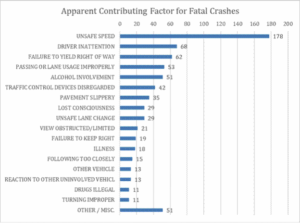
Apparent contributing factors for fatal crashes. Credit: Nelson\Nygaard
The Capacity Building team provided two locations in Suffolk County for participants to examine, each with different safety challenges, such as narrow bike lanes, oversized driveways with frequent conflicts, discontinuous sidewalks, narrow bike lanes, and speeding. The map included locations where injuries and fatalities occurred, in addition to existing cross-section dimensions. Participants considered contributing factors of collisions on the corridors, which included failure to yield, driver inattention.
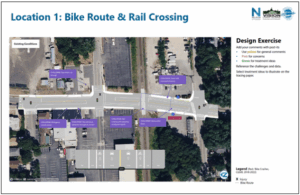
One of the locations participants examined during the design exercise.
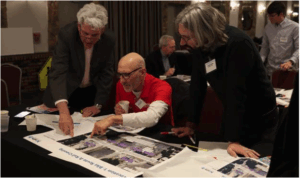
Participants examine intersections during the design exercise. Credit: Nelson\Nygaard
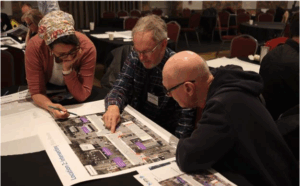
Participants examine intersections during the design exercise. Credit: Nelson\Nygaard
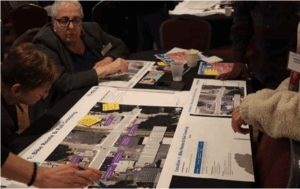
Participants examine intersections during the design exercise. Credit: Nelson\Nygaard
Of the five groups working on the design exercise, more than one proposed a traffic circle as a traffic calming measure at one of the intersections. Participants also suggested consolidating driveways, widening sidewalks, hardening bike infrastructure, and relocating bus stops away from busy intersections.
Next Steps for Vision Zero in Suffolk County
The funding that Suffolk County secured through the RAISE grant program will strengthen multimodal transportation across multiple jurisdictions. The funding will support the construction of the 12-mile Brentwood to Bethpage Connector and the project is a collaborative effort between the Trust for Public Land and Suffolk County, in addition to strong support from stakeholders and local partners, such as New York State Parks, Friends of Long Island Greenway, the Town of Huntington, and local elected officials.
Funding Opportunities
Suffolk County is in the process of finalizing the grant agreement to begin work on the Safe Streets for All (SS4A) Grant that they were awarded, and the Summit with Vision Long Island helped build momentum for street safety programming.
Key Partners
- The Trust for Public Land is a non-profit that has been operating since 1972, working throughout the United States to create, protect, and steward quality parks and green spaces. The organization focuses on equitable park access, facilities that improve social, physical, mental, and environmental health, making neighborhoods resilient against impacts of climate change, and creating stronger and more connected communities.
- Vision Long Island aims to support the growth of mixed-used/mixed-income communities that are pedestrian-friendly, accessible by public transit, and affordable. The organization has been working on Long Island for the last 25 years.
- Nelson\Nygaard Associates is the Thriving Communities Program (TCP) subcontractor.
- RMI is an independent, nonpartisan, nonprofit that transforms global energy systems through market-driven solutions to align with a 1.5°C future and secure a clean, prosperous, zero-carbon future for all. The nonprofit serves as prime contractor for TCP.
Related Resources
- Newsday coverage of the joint Summit and walk audit with Vision Long Island and Suffolk County on April 8, 2025: ‘Walking audits’ document Long Island road safety hazards – Newsday
- Newsday coverage of RAISE grant funding for Long Island Greenway: $36M federal grant to replace bridge on Veterans Memorial Highway, expand Long Island Greenway trail – Newsday
- Suffolk County Hike Bike Master Plan
Capacity building efforts through the Thriving Communities Program are continuing until May 2025. The Capacity Builder team will conduct more technical assistance activities and will update this case study as the program progresses.